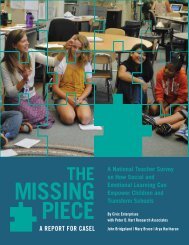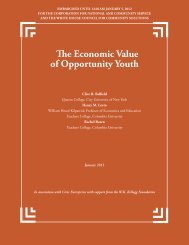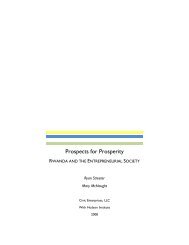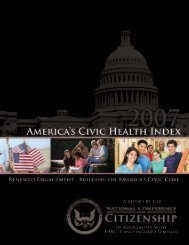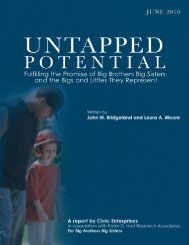A Call to Peace - Civic Enterprises
A Call to Peace - Civic Enterprises
A Call to Peace - Civic Enterprises
- No tags were found...
Create successful ePaper yourself
Turn your PDF publications into a flip-book with our unique Google optimized e-Paper software.
A CALL TO PEACEThis report is not a narration of the key moments in the life of the <strong>Peace</strong> Corps over its 50 years. Many books andarticles are devoted <strong>to</strong> this his<strong>to</strong>ry and we want <strong>to</strong> focus our attention on the perspectives of Returned <strong>Peace</strong> CorpsVolunteers (RPCVs). The beginning of the <strong>Peace</strong> Corps, however, is particularly significant in our view because itwas powered at the grassroots level, and set forth a framework that informs recommendations for the futureof the <strong>Peace</strong> Corps and international volunteering. We, therefore, take a moment <strong>to</strong> trace the roots of the<strong>Peace</strong> Corps here.The BeginningThe <strong>Peace</strong> Corps was not an original idea. DespiteTheodore Sorenson calling it “the only new proposal”candidate John F. Kennedy introduced in the1960 presidential campaign, it was not new. BothRepresentative Henry Reuss and Sena<strong>to</strong>r HubertHumphrey proposed the idea in the late 1950s. A bill,written by Representative Reuss, a Democrat fromWisconsin, was introduced in Congress in 1960. The billcalled for the study of a “Point Four Youth Corps,” pointfour being a reference <strong>to</strong> the fourth point in PresidentHarry Truman’s 1949 inaugural address, offeringtechnical assistance <strong>to</strong> developing nations. Congressapproved $10,000 for the study of such a corps.Sena<strong>to</strong>r Humphrey, who gave the <strong>Peace</strong> Corps its name,also introduced a bill in 1960 <strong>to</strong> establish an agencyand campaigned for the idea during the presidentialprimaries. His bill never came up for a vote. It wascandidate John F. Kennedy, in a rousing and impromptuspeech delivered on Oc<strong>to</strong>ber 14, 1960 at 2 a.m. on thesteps of the University of Michigan <strong>to</strong> an estimatedcrowd of 10,000 students who had waited in a coldnight for him <strong>to</strong> arrive after his televised debate withRichard Nixon, who inspired a generation of students<strong>to</strong> answer the call <strong>to</strong> service and gave life <strong>to</strong> a buddingidea that would become his most enduring legacy.The idea for a <strong>Peace</strong> Corps <strong>to</strong>ok off because of astudent movement that emerged behind it. Twostudents in attendance that night, Alan and JudyGuskin, <strong>to</strong>ok Kennedy’s remarks <strong>to</strong> heart, leadingthem <strong>to</strong> draft a petition and collect about a thousandstudent pledges <strong>to</strong> volunteer overseas in response<strong>to</strong> Kennedy’s challenge: “How many of you, who aregoing <strong>to</strong> be doc<strong>to</strong>rs, are willing <strong>to</strong> spend your days inGhana? Technicians or engineers, how many of you arewilling <strong>to</strong> work in the Foreign Service and spend yourlives traveling around the world?… on your willingness<strong>to</strong> contribute part of your life <strong>to</strong> this country…will depend the answer whether a free society cancompete.” Two weeks later, on November 2, 1960, ina speech at the Cow Palace in San Francisco, stirred bythe student petition, Kennedy officially proposeda peace corps of talented men and women who woulddedicate themselves <strong>to</strong> the progress and peace ofdeveloping countries.Sergeant Shriver said the <strong>Peace</strong> Corps “might stillbe just an idea but for the affirmative response ofthose Michigan students.” He called it a case of“spontaneous combustion” and says the <strong>Peace</strong>Corps thereafter tried <strong>to</strong> keep “the momentum andunbureaucratic spontaneity” of that campaign night. 3Candidate Kennedy on the steps of the University of Michigan, Oc<strong>to</strong>ber 14, 1960.Pho<strong>to</strong> courtesy of the University of Michigan.2 Meisler, S. (2011). When the World <strong>Call</strong>s: The Inside S<strong>to</strong>ry of the <strong>Peace</strong> Corps and Its First Fifty Years. Bos<strong>to</strong>n, MA: Beacon Press.3 Shriver, S. (1964). The Point of the Lance. Harper & Row.A CALL TO PEACE SEPTEMBER 20119|



